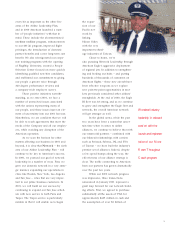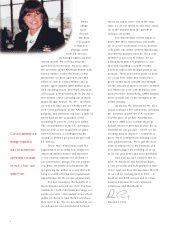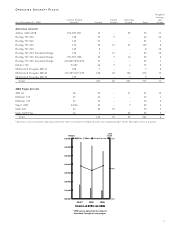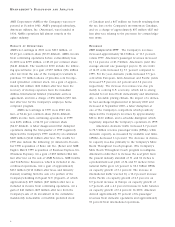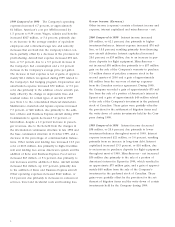American Airlines 2000 Annual Report Download - page 15
Download and view the complete annual report
Please find page 15 of the 2000 American Airlines annual report below. You can navigate through the pages in the report by either clicking on the pages listed below, or by using the keyword search tool below to find specific information within the annual report.
13
Foreign Currency The Company is exposed to the
effect of foreign exchange rate fluctuations on the U.S.
dollar value of foreign currency-denominated operating
revenues and expenses. The Company’s largest expo-
sure comes from the Canadian dollar, British pound,
Japanese yen, Euro and various Latin and South Ameri-
can currencies. The Company uses options to hedge a
portion of its anticipated foreign currency-denominated
ticket sales. The result of a uniform 10 percent strength-
ening in the value of the U.S. dollar from December 31,
2000 and 1999 levels relative to each of the currencies
in which the Company has foreign currency exposure
would result in a decrease in operating income of
approximately $33 million and $39 million for the years
ending December 31, 2001 and 2000, respectively, net
of hedge instruments outstanding at December 31, 2000
and 1999, due to the Company’s foreign-denominated
revenues exceeding its foreign-denominated expenses.
This sensitivity analysis was prepared based upon pro-
jected 2001 and 2000 foreign currency-denominated rev-
enues and expenses as of December 31, 2000 and 1999.
Interest The Company’s earnings are also affected
by changes in interest rates due to the impact those
changes have on its interest income from cash and
short-term investments, and its interest expense from
variable-rate debt instruments. The Company has
variable-rate debt instruments representing approxi-
mately 29 percent and 21 percent of its total long-term
debt, respectively, at December 31, 2000 and 1999, and
interest rate swaps on notional amounts of approxi-
mately $158 million and $696 million, respectively, at
December 31, 2000 and 1999. During 2000, the Com-
pany terminated interest rate swap agreements on
notional amounts of approximately $425 million. The
cost of terminating these interest rate swap agreements
was not material. If interest rates average 10 percent
more in 2001 than they did at December 31, 2000, the
Company’s interest expense would increase by approxi-
mately $11 million and interest income from cash and
short-term investments would increase by approxi-
mately $15 million. In comparison, at December 31,
1999, the Company estimated that if interest rates aver-
aged 10 percent more in 2000 than they did at Decem-
ber 31, 1999, the Company’s interest expense would
have increased by approximately $10 million and inter-
est income from cash and short-term investments would
have increased by approximately $11 million. These
amounts are determined by considering the impact
of the hypothetical interest rates on the Company’s
variable-rate long-term debt, interest rate swap agree-
ments, and cash and short-term investment balances
at December 31, 2000 and 1999.
Market risk for fixed-rate long-term debt is esti-
mated as the potential increase in fair value resulting
from a hypothetical 10 percent decrease in interest
rates, and amounts to approximately $148 million and
$156 million as of December 31, 2000 and 1999, respec-
tively. The fair values of the Company’s long-term
debt were estimated using quoted market prices or
discounted future cash flows based on the Company’s
incremental borrowing rates for similar types of borrow-
ing arrangements.
Investments The Company is subject to market risk
related to its ownership of approximately 1.2 million
depository certificates convertible, subject to certain
restrictions, into the common stock of Equant, as of
December 31, 2000 and 1999. The estimated fair value
of these depository certificates was approximately
$32 million and $136 million as of December 31, 2000
and 1999, respectively, based upon the market value
of Equant common stock.
In addition, the Company holds investments in
certain other entities which are subject to market risk.
However, the impact of such market risk on earnings
is not significant due to the immateriality of the carry-
ing value and the geographically diverse nature of
these holdings.


